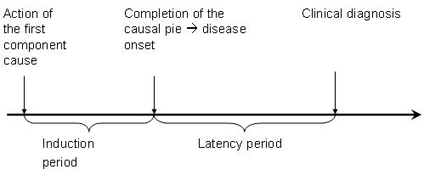2. Induction time
Induction time is the time interval between the action of a component cause and the start of disease or change in health status. Each component cause has its own induction time.
There are two ways of looking at induction time. Since the exposure to a potentially harmful agent may need to accumulate to a certain threshold, other factors have to be present before the disease can occur. Accumulation takes a period of time called 'the induction period.' Alternatively, the exposure may be the first event in a series of causal events that must occur for the disease to develop. For example, a syndrome may be the result of a) a susceptible individual's accumulated exposure to a chemical, leading to b) a genetic damage which leads to c) a decrease of a certain neurotransmitter. This process may take months or years. Individual susceptibility varies based on specific biological/ physiological factors[1].

N.B. Although the latency period in this case is defined as the time until clinical diagnosis of a disease, the disease might have been present even with symptoms but may not have been diagnosed.
Examples:
- Short induction time: Some conditions have very short induction times, such as an allergic reaction to eating peanuts that may occur within minutes. However, the predisposing factors for the allergy are other causes for the reaction that may have been present long ago, and therefore have a long induction time.
- Medium induction time: If rabies is not treated quickly after a bite from an infected animal it may develop into symptomatic disease from one to three months after the rabies virus enters the body.
- Longer induction time: It may take years for a person to develop lung cancer when smoking cigarettes.
[1] Adapted from: https://epiville.ccnmtl.columbia.edu/glossary.html#I